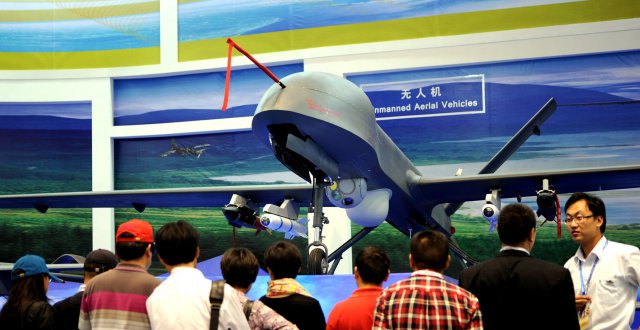 Iraq’s first lethal strike using a Chinese drone represents a major step forward in China’s drive to become a leading exporter of military equipment, experts say. Iraq is the only known export user of the drone, also known as the CH-4, which closely resembles the General Atomics MQ-9 Reaper.
Iraq’s first lethal strike using a Chinese drone represents a major step forward in China’s drive to become a leading exporter of military equipment, experts say. Iraq is the only known export user of the drone, also known as the CH-4, which closely resembles the General Atomics MQ-9 Reaper.
According to footage released by the Iraqi armed forces, soldiers used the Chinese drone on Dec. 6 to destroy an ISIS position amid efforts to retake the city of Ramadi. A spokesperson for the Ministry of Defense confirmed the video was real.
Its first use in combat may be a selling point for potential buyers.
“This is the first time I’ve heard of a Chinese drone, such as the CH-4 (which is basically a clone of the Reaper), reporting an actual kill, and I suppose it would be cliché to say that it won’t be the last,” Richard A. Bitzinger, a senior fellow at the S. Rajaratnam School of International Studies at Nanyang Technological University in Singapore, wrote in an email on Wednesday.
Mr. Bitzinger estimated that Iraq’s armed forces had to buy six to 12 Chinese drones to conduct operations efficiently.
“When the Iraqi MoD officially unveiled them in October, two ground control stations could be seen,” Jeremy Binnie, Middle East/Africa editor at IHS Jane’s Defence Weekly, wrote in an email, referring to the Ministry of Defense. “Given a typical setup of two aircraft per control station, Iraq probably has at least four.”
China also uses the CH-4. Its predecessor, the CH-3, has been sold to both Nigeria and Pakistan, he said.
Last year, China became the world’s third-largest arms exporter, behind the United States and Russia, according to the Stockholm International Peace Research Institute, a think tank in Sweden. China’s defense companies have been working hard to export higher-end systems — like drones, air defense systems and even stealth fighters — but with few successes so far.
The CH-4, whose name translates as “Rainbow,” is manufactured by the Beijing-based China Aerospace Science and Technology Corporation, a state-owned enterprise group. The drone “represents China’s research and production of drones march toward the world,” according to a news article from 2014 on the conglomerate’s website.
Calls and a fax sent to C.A.S.C. went unanswered.
The drone was first seen at an airshow in Beijing in 2013, according to China News Service. In March 2015, a state-run news agency said such drones had been handed to the Iraqi Air Force, citing Russian news reports. In October, Iraq’s defense minister inspected a Caihong drone at an air base in the city of Kut.
The CH-4 can strike from an altitude of about 16,000 feet and fly at up to 112 miles per hour, according to an article in China Space News, a publication run by C.A.S.C.
“What is clear is that the price of one Caihong-4 drone is much lower than the price of an advanced battle tank on the international arms market,” said the article, published in March.
The loss of a drone is “affordable even when military budgets are tight or in small countries,” it noted.
Chinese-built drones and aircraft are generally built to compete on price, experts say. Technological limitations mean the finished products do not often perform at the same level as their Western counterparts, but they are cheaper — and have far fewer restrictions on who can buy them.
“China is known to have difficulties in developing aero engine technology, and this is also true for UAV engines. As a result, Chinese UAVs are generally less capable in terms of performance,” Kelvin Wong, an Asia Pacific defense technology reporter with IHS, wrote in an email, referring to unmanned aerial vehicles.
As resources are scarce for Iraq’s armed forces, Chinese drones offer a fast alternative to allied air strikes, according to Jeffrey Lin and Peter W. Singer, who have traced reports of Chinese drone deployments in Iraq, Nigeria and Saudi Arabia.
“The long loiter time and precision weaponry of armed drones give small Iraqi units flexible and rapid response fire support to exploit sudden battlefield conditions,” they wrote in a blog post on on Tuesday.
Apart from the lower price of Chinese drones, restrictions imposed by the United States on the export of armed unmanned systems open a potentially lucrative market for Chinese manufacturers, Timothy R. Heath, a senior international defense research analyst with the RAND Corporation, wrote in an email.
“Considering the number of countries that have acquired or expressed interest in Chinese drones, the recent incident in Iraq in which a government uses Chinese armed drones to strike domestic insurgents may become more commonplace around the world,” he wrote.
Indeed, dozens of countries now manufacture reconnaissance drones, Mr. Bitzinger noted. And their use is all but expected on the modern battlefield.
“Now it appears that armed drones (Chinese, European, Iranian, Russian) are the next phase in this proliferation,” he wrote.
Photo: A CH-4 at the 9th China International Aviation and Aerospace Exhibition in 2012 – Liu Dawei/Xinhua, via AFP
Source: New York Times
